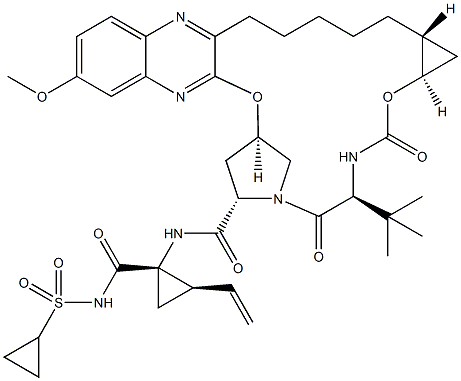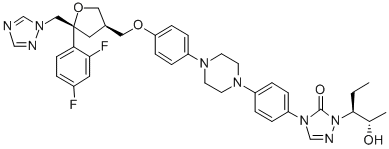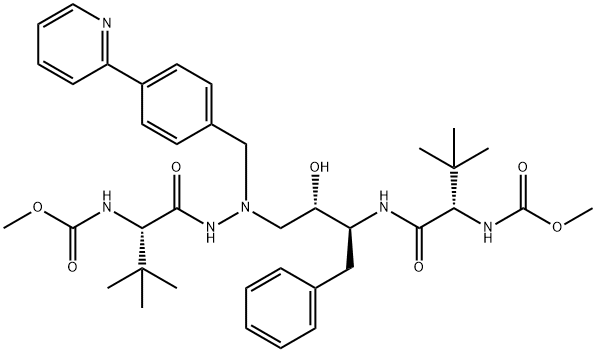MK5172
- CAS NO.:1350514-68-9
- Empirical Formula: C38H50N6O9S
- Molecular Weight: 766.9
- SAFETY DATA SHEET (SDS)
- Update Date: 2024-07-24 13:33:21

What is MK5172?
Absorption
Grazoprevir reaches peak plasma concentration 0.5-3 hours after administration . Grazoprevir has an absolute bioavailability of 27%. When taken with food the peak concentration of Grazoprevir increases 2.8 fold but this increase in exposure has not been deemed clinically relevant.
Toxicity
The most commonly reported adverse reactions of all intensity (greater than or equal to 5% in placebo-controlled trials) were fatigue, headache, and nausea .
The Uses of MK5172
MK 5172, also known as Grazoprevir, is a second-generation NS3/4A protease inhibitor that is often used in combination with the second-generation NS5A inhibitor, Elbasvir (E501010), for the treatment of hepatitis C virus infection. It is a COVID19-related research product.
Background
Grazoprevir is a direct acting antiviral medication used as part of combination therapy to treat chronic Hepatitis C, an infectious liver disease caused by infection with Hepatitis C Virus (HCV). HCV is a single-stranded RNA virus that is categorized into nine distinct genotypes, with genotype 1 being the most common in the United States, and affecting 72% of all chronic HCV patients . Treatment options for chronic Hepatitis C have advanced significantly since 2011, with the development of Direct Acting Antivirals (DAAs) such as Grazoprevir. Grazoprevir is an inhibitor of NS3/4A, a serine protease enzyme, encoded by HCV genotypes 1 and 4 . These enzymes are essential for viral replication and serve to cleave the virally encoded polyprotein into mature proteins like NS3, NS4A, NS4B, NS5A and NS5B . The barrier for develoment of resistance to NS3/4A inhibitors is lower than that of NS5B inhibitors, another class of DAAs . Subtitutions at amino acid positions 155, 156, or 168 are known to confer resistance. The substitutions of the enzyme's catalytic triad consisting of H58, D82, and S139 are also likely to alter the affinity of the drug for NS3/4A or the activity of the enzyme itself. Despite this disadvantage Grazoprevir is still effective against HCV particularly when paired with Elbasvir.
In a joint recommendation published in 2016, the American Association for the Study of Liver Diseases (AASLD) and the Infectious Diseases Society of America (IDSA) recommend Grazoprevir as first line therapy in combination with Elbasvir for genotypes 1a, 1b, and 4 of Hepatitis C . Grazoprevir and Elbasvir are used with or without Ribavirin with the intent to cure, or achieve a sustained virologic response (SVR), after 12 weeks of daily therapy. SVR and eradication of HCV infection is associated with significant long-term health benefits including reduced liver-related damage, improved quality of life, reduced incidence of Hepatocellular Carcinoma, and reduced all-cause mortality .
Grazoprevir is available as a fixed dose combination product with Elbasvir (tradename Zepatier) used for the treatment of chronic Hepatitis C. Approved in January 2016 by the FDA, Zepatier is indicated for the treatment of HCV genotypes 1 and 4 with or without Ribavirin depending on the the presence of resistance associated amino acid substitutions in the NS5A protein and previous treatment failure with Ribavirin, Peginterferon alfa-2a, Peginterferon alfa-2b, or other NS3/4A inhibitors like Boceprevir, Simeprevir, or Telaprevir . When combined together, Grazoprevir and Elbasvir as the combination product Zepatier have been shown to achieve a SVR between 94% and 97% for genotype 1 and 97% and 100% for genotype 4 after 12 weeks of treatment . It can be used in patients with compensated cirrhosis, human immunodeficiency virus co-infection, or severe kidney disease.
Indications
Grazoprevir is indicated in combination with Elbasvir (as the fixed dose combination product Zepatier) with or without Ribavirin for treatment of chronic HCV genotypes 1a, 1b, or 4 infection in adults.
Definition
ChEBI: An azamacrocyclic compound that is a hepatitis C protease inhibitor used in combination with elbasvir (under the brand name Zepatier) for treatment of chronic HCV genotypes 1 or 4 infection in adults.
Pharmacokinetics
Grazoprevir is classified as a direct-acting antiviral (DAA) and prevents viral replication in HCV genotypes 1a, 1b, and 4 .
Metabolism
Grazoprevir is partially eliminated by oxidative metabolism meditated by CYP3A . No circulating metabolites of have been detected in human plasma.
Properties of MK5172
| Density | 1.38±0.1 g/cm3(Predicted) |
| storage temp. | Sealed in dry,Store in freezer, under -20°C |
| solubility | ≥38.35 mg/mL in DMSO; insoluble in H2O; ≥24 mg/mL in EtOH with gentle warming and ultrasonic |
| form | solid |
| pka | 4.48±0.40(Predicted) |
| color | White to off-white |
Safety information for MK5172
Computed Descriptors for MK5172
MK5172 manufacturer
New Products
(S)-3-Aminobutanenitrile hydrochloride 4-Methylphenylacetic acid N-Boc-D-alaninol N-BOC-D/L-ALANINOL Tert-butyl bis(2-chloroethyl)carbamate N-octanoyl benzotriazole 3-Morpholino-1-(4-nitrophenyl)-5,6-dihydropyridin- 2(1H)-one Furan-2,5-Dicarboxylic Acid S-2-CHLORO PROPIONIC ACID ETHYL ISOCYANOACETATE 2-Bromo-1,3-Bis(Dimethylamino)Trimethinium Hexafluorophosphate 4-IODO BENZOIC ACID 3-NITRO-2-METHYL ANILINE 1-(2,4-DICHLOROPHENYL) ETHANAMINE (2-Hydroxyphenyl)acetonitrile 4-Bromopyrazole 5,6-Dimethoxyindanone 2-(Cyanocyclohexyl)acetic acid 4-methoxy-3,5-dinitropyridine 1-(4-(aminomethyl)benzyl)urea hydrochloride 2-aminopropyl benzoate hydrochloride diethyl 2-(2-((tertbutoxycarbonyl)amino) ethyl)malonate tert-butyl 4- (ureidomethyl)benzylcarbamate Ethyl-2-chloro((4-methoxyphenyl)hydrazono)acetateRelated products of tetrahydrofuran
You may like
-
 2033-24-1 98%View Details
2033-24-1 98%View Details
2033-24-1 -
 42831-50-5 5-METHYLISOXAZOLE-4-CARBOXYLIC ACID 98%View Details
42831-50-5 5-METHYLISOXAZOLE-4-CARBOXYLIC ACID 98%View Details
42831-50-5 -
 1975-50-4 98%View Details
1975-50-4 98%View Details
1975-50-4 -
 2-HYDROXY BENZYL ALCOHOL 98%View Details
2-HYDROXY BENZYL ALCOHOL 98%View Details
90-01-7 -
 2-Chloro-1,3-Bis(Dimethylamino)Trimethinium Hexafluorophosphate 221615-75-4 98%View Details
2-Chloro-1,3-Bis(Dimethylamino)Trimethinium Hexafluorophosphate 221615-75-4 98%View Details
221615-75-4 -
 61397-56-6 CIS BROMO BENZOATE 98%View Details
61397-56-6 CIS BROMO BENZOATE 98%View Details
61397-56-6 -
 14714-50-2 (2-Hydroxyphenyl)acetonitrile 98+View Details
14714-50-2 (2-Hydroxyphenyl)acetonitrile 98+View Details
14714-50-2 -
 118753-70-1 98+View Details
118753-70-1 98+View Details
118753-70-1

